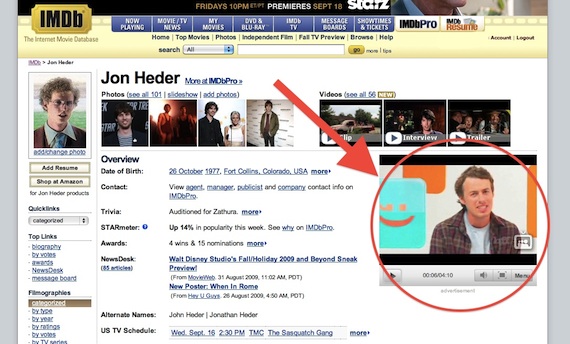Jim Louderback is a vocal critic of the current state of ‘views’ in online video. In a guest column in AdAge today, Louderback, who’s also the CEO of Revision3, continued to lambast the industry for rampant misrepresentatation of viewership counts on videos. The worst culprit of all? The dreaded embedded autoplay.
“And recently I’ve come to find the off-site—or embedded autoplay—as a particularly heinous malodorous video view,” he writes. “Why? Because many embedded autoplay videos often get streamed to pages that have zero content relationship to the video served, and often play below the fold with audio turned off.”
The timing of this conicides with TubeMogul releasing today an updated version of their “What Counts As a View” study that breaks down the varying threshold of the major video sites. The overall conclusion was that the views threshold has in fact become less stringent that their original 2008 study. Blip.tv still stands as the most stringent, counting only one view per IP address per session, whereas sites like Dailymotion and Yahoo Video are much more liberal in what counts. Some have tigheten up, like YouTube which used to count embedded autoplaying videos as separate views until a Avril Lavigne fans tried to game the system to make her the popular of all time.

Subscribe for daily Tubefilter Top Stories
Embedded Autoplay
We’ve been against the concept of embedded autoplay here at Tubefilter as well, especially when the networks or creators turn around and pitch us their web series that is allegedly a “hit” with millions of views, even when they are really counting all those autoplaying paid views. Remember when we caught MySpace buying views for their game show series BFF?

In this case it isn’t so much fraud as it is the unspoken truth that most major branded entertainment series have built in a sizable media buy into the overall deal. A network like MySpace may promise to deliver say 10 million views for that series within the brand’s target demographic. If they don’t reach that organically just by posting on site—which hardly ever seems to happen—they turn to the practice of syndication of those videos through ad networks like Tremor Media, SpotXchange and Heavy. The video often gets placed in display ad units around the web as an embedded autoplay video—we’ve all seen them. (Even our ad network partner here at Tubefilter, Technorati Media, has been known to run them from time to time.)
For BFF, it was P&G’s Always brand along with Ortho Women’s Health & Urology that were on board to back the show. And part of their allocated budget was set aside for this very practice. So the brand itself wasn’t really getting misled, at least not directly. Instead they were getting sold on the idea that online video series and campaigns are really just rich media display ads with video. Their target customers (hopefully) will get blasted with the video spots which will hopefully lure them in or at least passively expose them to the brand message.
But really, it devalues all those real web series that have captured a genuine audience that comes back time and again.
Seeking Standards
Some organizations including the IAWTV, a group of online video industry professionals and creatives, are looking to define a set of standards that the industry can agree on. The IAWTV has set up a standards committee, chaired by Louderback, that is addressing this very issue. (In full disclosure, I’m also a member of the committee though I’m not writing on its behalf here.)
Louderback suggests in his AdAge column the idea of an alternate way of looking at the autoplay conundrum, taking a nod from an existing term in the advertising world.
But recently I’ve begun to soften my stance to play-starts—whether user initiated or autoplay—It’s clearly not a video view in any sense of the word, but it is something. And that something actually hearkens back to a traditional TV metric, called OTS, or “Opportunity to See.” I discovered the view to OTS connection from Anne Drake, the head of research and analytics at Kantar Video. According to Anne, OTS simply measures whether a piece of video (typically an ad) was actually delivered to a physical TV set, not whether someone actually saw it. And that makes sense, if you think about pre-DVR TV, where viewers often used ad breaks to grab a snack, use the bathroom, or annoy their little sister. – Jim Louderback
The challenge with standards is finding something that is universally accepted amongst a critical mass of the industry. Right now in online video, it’s the advertisers that are calling the shots. So step one is actually separating their needs to quantify paid media buying with that of the unpaid, organic audience attention.
Separating view counts out into paid views (or perhaps OTS as Louderback proposes) versus organic views, would allow both the brands and the creatives to actually assess how effective a online video or web series was at reaching a real audience.
Web video creators The Fine Brothers (Benny and Rafi) have long been advocates of transparency in view counts and have spoken out against view count fraud and manipulation. In a recent email they wrote:
The public should know the difference to get transparency of the web video world, and let advertisers understand what they are paying for, and then decisions can be made on what’s more important to a potential sponsor, studio, etc – engaged sustained viewer ship, or impressions. This difference should be public knowledge and we should not have to continue dealing with what is, in our opinion, one of the biggest issues in the space right now which is over the top view numbers being touted on series that have no actual fan base which is destroying expectations about the reality of a successful online video/series. – The Fine Brothers
Where the standards come from will still remain to be seen. Headway may be able to be made first with the video portals themselves—blip.tv, YouTube, Vimeo and the like—which sit at the front of the consumer facing experience of online video. The metrics firms like comScore, Kantar and Nielsen will also play into this as they demo and roll out all sorts of different metrics for their paying ad clients. But just as the GRP (Gross Rating Point) became the standard number for TV, in order to get widescale adoption, there’s most likely going to need to be one metric that becomes the default. The water cooler number.
Can that default metric still be a view? Or is something else better in your opinion? We want to know. Leave a comment below and we may quote you for our next piece on this issue.








